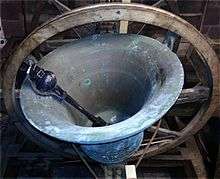Death knell
A death knell is the ringing of a church bell immediately after a death to announce it. Historically it was the second of three bells rung around death, the first being the passing bell to warn of impending death, and the last was the lych bell or corpse bell, which survives today as the funeral toll.
English tradition
In England, an ancient custom was the ringing of bells at three specific times before and after death. Sometimes a passing bell was first rung when the person was still dying,[1][2] then the death knell upon the death,[3] and finally the lych bell, which was rung at the funeral as the procession approached the church. The ringing of the lych bell is now called the funeral toll.[4] The canon law of the Church of England also permitted tolling after the funeral.
During the reign of Henry VIII and Elizabeth I, statutes regulated death knell,[5][6] but the immediate ringing after death fell into disuse. It was customary in some places by the end of the 19th century to ring the death knell as soon as notice reached the clerk of the church (parish clerk) or sexton, unless the sun had set, in which case it was rung at an early hour the following morning.[7] [8] Elsewhere, it was customary to postpone the death knell and tellers to the evening preceding the funeral, or early in the morning on the day of the funeral to give warning of the ceremony.[9]
The use of the passing bell for sick persons is indicated in the advertisements of Queen Elizabeth in 1564: "[W]here any Christian bodie is in passing, that the bell be tolled, and that the curate be specially called for to comfort the sick person".[10]
Manner of ringing
The manner of ringing the knell varied in different parishes. Sometimes the age of the departed was signified by the number of chimes (or strokes) of the bell, but the use of "tellers" to denote the sex was almost universal. For instance in the greater number of churches in the counties of Kent and Surrey they used the customary number of tellers, viz., three times three strokes for a man, and three times two for a woman; with a varying usage for children. The word "tellers" became changed into "Tailors".[11] J. C. L. Stahlschmidt described of the practices at each church in Kent and Surrey in his two books about the bells of those counties.[12][13]
Half-muffled bells

A modern tradition at funerals where there are full circle ring of bells is to use "half-muffles" when sounding one bell as a tolled bell, or to ring all the bells half-muffled in change ringing. Half-muffling means a leather muffle is placed on one side only of the clapper of each bell so that there is a loud "open" strike followed by a muffled strike, which has a very sonorous and mournful echo effect. Fully muffled bell ringing is very rare as the loud and soft effect is lost.
An excellent example of this was demonstrated with the bells of Westminster Abbey at the Funeral of Diana, Princess of Wales in 1997.
The accompanying picture shows a half-muffled full-circle bell, with the bell in the inverted position (or the "up" position). The clapper is shown resting on the lower side of the bell's soundbow, and when it first rotates (to the right in the picture) the un-muffled side of the clapper will strike when the bell rises to the inverted position and the clapper is moving faster and crosses to the other side. On the return stroke the same happens but the strike will be muffled. Note that only bells swung through a large arc or full-circle can be half-muffled, as it requires considerable rotation of the bell to strike on both sides of the clapper. The tradition in the United Kingdom is that bells are only fully muffled for the death of a sovereign.
See also
References
- Walters p. 156. Waters also notes that "there was sometimes the inconvenience that though the Passing Bell had been duly rung, the dying person might recover".
- Timbs, John (1863). Mysteries of Life, Death, and Futurity: Illustrated from the Best and Latest Authorities (13th ed.). New York: J. G. Gregory. p. 211.
- Brand, John; Ellis, Henry. Observations on the Popular Antiquities of Great Britain: Chiefly Illustrating the Origin of Our Vulgar and Provincial Customs, Ceremonies, and Superstitions. 2 (New ed.). p. 202.
- Walters p. 160.
- Timbs, John (1867). "Funeral Customs". Things Not Generally Known: Familiarly Explained (11th ed.). London: Lockwood & Company. p. 185.
- "Correspondence: Answers; The Passing Bell". The Churchman's Companion. New Series. III (XVII): 471. May 1868.
- Thomas Hood, "Faithless Sally Brown": "His death which happened in his berth, At forty-odd befell: They went and told the sexton, and The sexton tolled the bell".
- Walters p. 157.
- Walters p. 160.
- Walters p. 155.
- Walters p. 157–58.
- Stahlschmidt, J. C. L. (1887). The Church Bells of Kent: Their Inscriptions, Founders, Uses and Traditions. London: Elliot Stock. p. 126.
- Stahlschmidt, J. C. L. (1884). Surrey Bells and London Bell Founders: A Contribution to the Comparative Study of Bell Inscriptions. London: Elliot Stock. p. 124.
- Walters, Henry Beauchamp (1912). The Church Bells of England. London: Oxford University Press. OCLC 1041787776. OL 13508613M. Retrieved April 6, 2019.
External links
- 2016 Armistice Day, St Bees, Cumbria on YouTube, depicting muffled English full circle-ringing, first eight bells, then one bell tolling